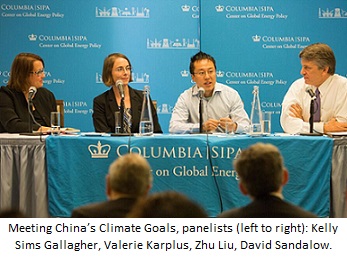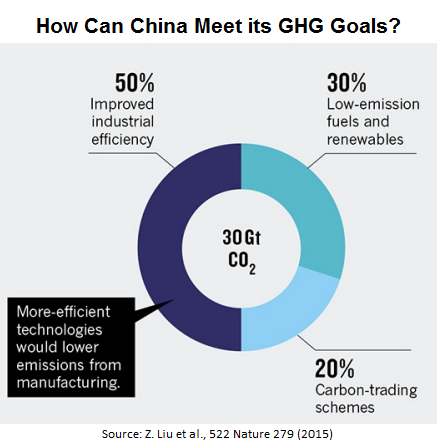 Earlier this week, the Sabin Center and the Center on Global Energy Policy (CGEP) co-hosted a panel discussion on Meeting China’s Climate Goals. The event was convened to discuss how China can shift its economy away from coal-fired power generation, improve energy efficiency, and increase the share of low carbon energy sources in its economy, and how the US and China can work together to promote their shared climate objectives. A video of the event and copies of the speakers’ presentations are available here.
Earlier this week, the Sabin Center and the Center on Global Energy Policy (CGEP) co-hosted a panel discussion on Meeting China’s Climate Goals. The event was convened to discuss how China can shift its economy away from coal-fired power generation, improve energy efficiency, and increase the share of low carbon energy sources in its economy, and how the US and China can work together to promote their shared climate objectives. A video of the event and copies of the speakers’ presentations are available here.
An Overview of Chinese Emissions, Targets, and Policies
David Sandalow, the Inaugural Fellow at CGEP, commenced the discussion with an overview of China’s GHG emission trajectories and targets, the policies that have been introduced to achieve those targets, and recent developments in China-U.S. diplomacy. While China’s GHG emissions have skyrocketed in the past decade, surpassing the U.S. to become the largest global emitter, this has coincided with an equally dramatic increase in the country’s Gross Domestic Product (GDP) and one of the most successful poverty reduction programs on the planet. As of 2012, China’s GHG emissions totaled approximately 11 gigatons (GT), which is nearly equal to the combined emissions of the US and the European Union (EU). However, China’s per capita GHG emissions (6.7 tons) are still much lower than the US (17 tons) and similar to the EU (7.1 tons). China’s cumulative emissions are also much lower than those of the U.S. and other developed countries.
Earlier this year, China announced that it intends to have economy-wide CO2 emissions peak by 2030, as part of its Intended Nationally Determined Contribution (INDC) to the United Nations Framework Convention on Climate Change (UNFCCC). During this period, China also intends to reduce its CO2 emissions per unit of GDP by 60-65% over 2005 levels. To achieve these goals, China has introduced a variety of policies aimed at reducing the use of coal, increasing the share of energy from natural gas and non-fossil sources, and improving energy efficiency. China is also currently experimenting with cap and trade systems—seven pilot projects are already underway, and the country intends to launch a national program in the near future.
Sandalow concluded by discussing some of the recent developments in US-China diplomacy on climate change, including last year’s “historic agreement” in which both countries estimated tentative GHG targets and agreed to work constructively towards an ambitious global climate agreement in 2015, and the US-China Clean Energy Research Center. He concluded that there was “enormous potential” for the two countries to continue working together to promote both domestic and international action to reduce GHG emissions.
A Political Perspective on China’s Climate Change Policies
Kelly Sims Gallagher, Professor of Energy and Environmental Policy at the Fletcher School, Tufts University, highlighted key three points related to China’s ability to meet its GHG targets. First, she noted that China has fundamentally altered its policy approach, moving from a regulatory system based on ideology to one that is firmly grounded in pragmatism. Whereas China previously viewed climate change as a predominantly global issue, with its primary role being to coordinate with other G77 countries, Gallagher said that China is now pursuing “concrete” and “ambitious” domestic policies to address GHG emissions. For example, China is expanding its clean energy base faster than any other country in the world. China has also become more active in pursuing diplomatic measures outside of the UNFCCC context to persuade other countries to increase their ambition with respect to climate change mitigation.
Second, she said that China now seeks to become a “responsible stakeholder” in the international context, and that China is well on its way to achieving this goal. In particular, she highlighted China’s recent leadership at the UNFCCC, its joint announcement with the US, and the recent US-China Climate Leaders Summit in which nine Chinese cities agreed to peak GHG emissions in advance of the national target.
Third, Gallagher noted that it is important to think about how China should focus its policies after the Paris Agreement. She noted that innovation will be needed to address some deficiencies in the domestic regulatory system—in particular, the combination of national targets and decentralized implementation creates challenges for accountability and enforcement. She recommended more experimentation with price instruments, such as a carbon tax, as this could streamline the implementation and enforcement process. As another domestic policy innovation, Gallagher recommended that China also focus on making its people and infrastructure more resilient to the impacts of climate change. Finally, Gallagher noted that, in the international context, it will be important for China to think about greening overseas development finance and focusing more on the finance of GHG mitigation projects.
A Technical Perspective on China’s GHG Emission Control Pathways
Zhu Liu, a Fellow at the California Institute of Technology’s Resnick Sustainability Institute and an Associate at Harvard’s Belfer Center for Science and International Affairs, provided a more technical perspective on China’s ability to meet its GHG targets. He provided a more in-depth overview of GHG emission trends, including an overview of carbon intensity for different sectors, imports, and exports. He noted that Chinese products are much more carbon intensive than those found elsewhere, but that there are significant opportunities for improvement.
Specifically, Liu highlighted three key opportunities for China to meet its GHG goals, and the respective percentage of GHG emission reductions (as compared with business as usual) that could be achieved through those opportunities: improving industrial efficiency (50%), using low emission fuels and vehicles (30%), and implementing a carbon trading scheme (20%). Read the full report here.
Policy Scenarios from the Tsinghua-MIT China Energy and Climate Project
Valerie Karplus, Assistant Professor of Global Economics and Management at MIT Sloan School, and Director of the Tsinghua-MIT China Energy and Climate Project, discussed how China’s energy mix and GHG emissions would differ under three policy scenarios: a “no policy” scenario, a “continued effort” scenario, and an “accelerated effort scenario.” She noted that China is now on the “accelerated effort” pathway, and that the country’s CO2 emissions will likely peak between 2025 and 2035 and then slowly decline through 2050. Even under this pathway, China will continue to consume a considerable quantity of coal (with coal consumption peaking in 2020 and declining slowly thereafter), as well as an increasing amount of oil. Under this pathway, her team predicted that China’s energy-related CO2 emissions will peak in 2030 at 10.1 billion metric tons (BMT), and slowly decline to approximately 8.5 BMT in 2050. Read the full report here.
Can China Meet or Even Exceed Its GHG Targets?
Several panelists noted that China’s goals were ambitious in light of its current economic situation. For example, Sandalow noted that, when China intends to reach peak emissions in 2030, the projected GDP per capita will only be $15,000 per person. This is in stark contrast to the EU, where emissions peaked in 1992 with $30,000 GDP per capita, and the US, where emissions peaked in 2007 with $50,000 GDP per capita.
Ultimately, the speakers were all optimistic about China’s ability to meet its GHG targets. In fact, two of the speakers (Valerie Karplus and Kelly Sims Gallagher) indicated that China may achieve peak emissions as early as 2025, thus exceeding its targets. Zhu Liu was also cautiously optimistic about this prospect. However, all speakers acknowledged that the date at which China achieves peak emissions is less important than the level of emissions and the overall shape of the emissions trajectory. And China has yet to announce any quantitative targets specifying a peak emissions level or interim emissions levels.
There are also important questions about China’s ability to implement these targets without additional actions to improve transparency, accountability, and enforcement in its regulatory system. Local officials are often responsible for the oversight and enforcement of environmental laws, but many of these officials lack the political will or capacity to fully execute these functions. For example, in 2014, China introduced requirements for 15,000 firms to install monitoring equipment and make real-time public disclosures of emissions of air pollutants, wastewater and heavy metals—but according to one article, “enforcement has been weak because most local officials are more concerned with economic growth than with preventing pollution.” The “fragmented and overlapping structure” of environmental governance in China and the fact that “enforcement and implementation… may be foiled by a lack of capacity and conflicts of interest” were both cited among the shortfalls in its China’s new Environmental Protection Law.
In addition, China may need to amend certain policies that would undermine its ability to control and eventually reduce GHGs. For example, China currently provides extensive fossil fuel subsidies (which totaled approximately 2.59% of the country’s GDP in 2010). And according to the Institute for Energy Research, China added 39 gigawatts of coal-fired capacity in 2014, and is expected add the equivalent of a new 600-megawatt plant every 10 days for the next 10 years. The new coal plants are more efficient and cleaner than older coal plants—but they will still produce substantial GHG emissions for decades.
That said, China has also been dramatically increasing its clean energy capacity. According to one Chinese solar company, the country is on track to install 17.8 gigawatts of solar energy in 2015. As a point of comparison, the total capacity of solar PV installations in the US only recently surpassed 20 gigawatts. Both countries have committed to continue working together on the development and deployment of clean energy solutions, and are currently implementing a variety of collaborative projects through the U.S.-China Renewable Energy Partnership.



